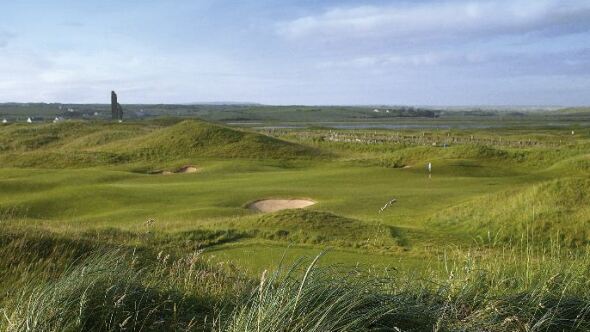COUNTY KERRY, Ireland -- Passionate about their sport, it's easy to understand why the Irish love golf for it has all the right ingredients.
It's played in the fresh air and in the most gorgeous of settings, which appeals to the romantic Irish. It takes a deal of time and can't be rushed, which strikes a sympathetic chord in a society not given to undue haste or gripped with an enormous sense of urgency.
And then there's the humor. Golf offers almost unlimited scope for mirth and the Irish appreciate a good laugh at least as much as they do a hot tip in the last race at Fairyhouse.
And, finally, it affords an almost unrivaled opportunity to indulge in what the Irish do brilliantly well, which is talk at length about anything and everything without reaching any particular conclusion.
So it should come as no surprise that Ireland produces a great many more talented golfers than is reasonable and has far more fabulous courses than it really needs. Three of the very best are in the southwestern counties of Kerry and Clare.
But splendid though they undoubtedly are, these golf courses are only part of the appeal of golf in Ireland. What makes it irresistibly attractive are the wonderful characters and barely believable stories that enrich the overall experience.
President Clinton, who first played the Old Course at Ballybunion Golf Club in September 1998, recounted one such story. Before he teed off, his caddie asked him how many Irish golf courses he'd played. When he said, "Just two" the caddie commented, "Then the bet's good." It transpired that the caddie had offered odds of 20-1 that his man wouldn't break a hundred. Despite a 12 and two sevens, President Clinton just squeezed under the target and the caddie lost comfortably more than he earned that day. To say the Irish like a bet is akin to suggesting they enjoy a sip of Guinness now and again.
Clinton has been back several times and famously drove into the cemetery well to the right of the opening fairway. When he shouted "fore", the starter suggested he was wasting his breath. "Nobody in there is worried about getting hurt."
Although there's certainly no shortage of Irish characters, it was Tom Simpson, an English eccentric, who deserves much of the credit for improving the Old Course at Ballybunion. Back in the 1930s and with no funds to spend, the club turned to him for help. An independently wealthy man who enjoyed the luxury of turning a hobby into a career, he happily accepted the challenge.
Simpson always turned up for work in a chauffer-driven silver Rolls Royce, wearing a flowing cloak and beret, wielding a riding crop and accompanied by his stunningly beautiful wife, Molly Gourlay, an accomplished golfer in her own right.
The chauffeur would polish the Rolls and then drive it onto a pre-designated fairway at the appropriate time to serve lunch from an enormous wicker basket. Because it was their favorite picnic spot, the two pot bunkers in the middle of the first fairway (back then it was the 14th) are named "Mrs. Simpson's" after Molly and not, as is often thought, Wallis Simpson, the Duchess of Windsor.
The Old Course has recently been tweaked by Martin Hawtree, another famous English architect who not that long ago helped restore nearby Lahinch Golf Club to its former glory. Opened in 1892, Lahinch had previously been modified by a succession of great names, including Old Tom Morris, George Gibson and Alister MacKenzie. In 1927, MacKenzie improved the course enormously and went on to design such icons as Augusta National, Pebble Beach and Cyprus Point.
A purist, MacKenzie passionately believed in using the existing attributes of a site and keeping a course's natural appearance. Holes weaved through the dunes and the greens rolled with the natural fall of the land. Who was responsible and why it was done no one seems to know, but the greens were flattened considerably in the 1930s.
"I think they were altered simply because the members found them a bit too difficult," said Robert McCavery, who has been the pro at Lahinch for more than 50 years. His father was the pro before him and McCavery remembers his dad walking home to lunch across the course, pausing every so often to remove a weed with the penknife he always carried.
In 1999, Hawtree was asked to restore the MacKenzie characteristics of the Old Course (there's a gentler Castle Course at Lahinch as well). Only four greens and two tees weren't touched. The "restored MacKenzie" course received a rapturous reception and Lahinch has since soared back up the rankings.
Photos of famous golfers, including Phil Mickelson (twice), Tom Watson, Stewart Cink, Ian Baker-Finch and dozens of others, hang on every wall in the pro shop. There's even one of Neil Armstrong, who may have walked on the moon but never won a major. The other person in nearly every shot is McCavery, who keeps a camera handy at all times because, "You never know who's going to drop in."
A more modern great Irish links is Tralee Golf Club. Arnold Palmer designed it and said that he is proud of the outward nine but really didn't have much to do with the back nine because, "God had already designed it."
There are wonderful views of the Atlantic from every hole and its elevated location leaves it particularly exposed. A calm day here is even harder to come by than an Irishman who doesn't like a drink.
"Links golf tests temperament in a stringent manner because good shots can end up bad and bad shots can finish up good," said David Power, the professional at Tralee. "One doesn't always get what one deserves. Be patient, accept the challenges and regard it as part of the fun. That's what the Irish do."
Power suggests the trick is "to use the wind rather than fight it by playing punch shots with a choked-down grip and restricted follow-through. Play by feel, imagination and trajectory control. Remember, the best scrambler wins."
And, more important, try and have as much fun as the Irish always do.














